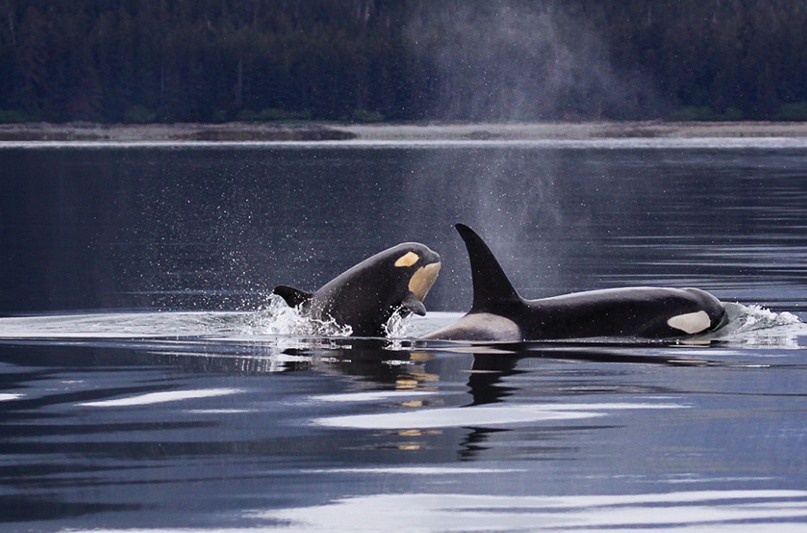The Last Generation. That is the title of the local Fox affiliate’s story on the crisis facing the population of Southern Resident Killer Whales. Only 75 whales exist as part of the J, K, and L pods as of June 2018.
And maybe the “last generation” isn’t too far off. By now, you have seen the awful story of the Southern Resident Killer Whale carrying her dead calf around the west coast of San Juan Island. Not only is it heartbreaking but it also brings more attention to Governor Jay Inlsee’s 44-person Southern Resident Killer Whale Task Force, which includes NMTA’s President George Harris and recreational angler Ron Garner. This group will meet four times around the state. Plus, there are subcommittees in place to further drill down on three areas that affect the health of whales. These groups are looking at toxins, vessel noise, and the lack of salmon, the killer whale’s main food source. All three topics interface with boating one way or another, and it’s crucial that we boaters have representation. It’s too early to see what will ultimately come from this group, which wraps up on October 1, but I can tell you that Governor Inslee is looking to this cross-section of Washington state’s civic and elected leaders for guidance and direction.
And let’s just say there are some pretty heavy decisions ahead of them. The list includes reducing the number of pinnipeds (that’s a fancy word for seals and sea lions) in Puget Sound, which gorge themselves on salmon. Not to be outdone, there’s talk about the role of hydroelectric power and the benefits of overflow spills in the Columbia River. That’s cover for talking about dam removal along the Snake River, the Columbia River’s largest tributary. Then there’s Chinook salmon. Hatchery production, long-heralded for saving recreational fishing in the Northwest, might be the answer (although some science indicates that these whales prefer wild Chinook), but if the hatchery number gets too high, implications arise with an Endangered Species Act-listed Chinook population.

Speaking of the Endangered Species Act and wild Chinook, did you know that our state allows gillnetters to indiscriminately kill wild Chinook while they go about their catches? Recreational anglers can target hatchery-produced salmon – they return wild Chinook and keep the clipped adipose-finned, hatchery-produced salmon. The tribes and commercial anglers, when they go about using gillnets capture everything that gets tangled up in those nets. And as long as Rep. Brian Blake from the Ilwaco area runs his committee in Olympia, the commercial anglers will have a champion in place to protect their interests.
And the list keeps growing and gets closer to home when it comes to the type of gear on a recreational boat. Another topic that’s picked up steam in this task force is the amount of noise put off by your boat. Whales are susceptible to transducer responders on vessels. It will be interesting to see how recreational vessels compare with the behemoth Washington state ferry fleet. There’s also the current closure to the west side of San Juan Island to recreational boats, but not tribal or commercial vessels.
If I seem apprehensive that this group will come up with a bold, systems-thinking approach to their conclusion, it might be because I’ve seen this movie before. The list is long and the grey hairs are many. Whether it’s targeting recreational boats (and businesses) with Seattle’s fetish with bike lanes over marine interests, or reducing the amount of drawbridge openings in Seattle, or the No Discharge Zone, I know all too well what happens when good intentions meet immediate deadlines. Add a quarter cup of influentials, who have nothing to do with recreational boating, and it’s easy to see how limiting access, funding, and ease of recreational boating can occur.
On the flip side of my cynicism, I am very encouraged to see what’s happening as the National Electrical Code for 2020 gets developed. Thankfully, we have a voice on this code-development panel and we have Washington’s stake in the ground that 100 milliamps for an entire facility is safe. You may remember that Washington pushed back at Labor & Industries; convened multiple meetings; and provided data to them that 30 milliamps is neither realistic or any safer than 100 milliamps (especially in salt water). This important work took hold both in the Evergreen State and spread to a national panel in Washington, D.C.
As On Watch observes a current hot issue (orcas) and looks at an ongoing debate (the National Electrical Code), I want to end this column with a newish issue for boaters to bookmark. While you may hear about the current administration reducing regulatory burdens, there’s a movement afoot within the National Marine Fisheries Service to drag out (or even flat-out reject) permits for fixes to current docks and marinas. I’m in the “learning more” phase on this issue, but talk about an issue that impacts us all!